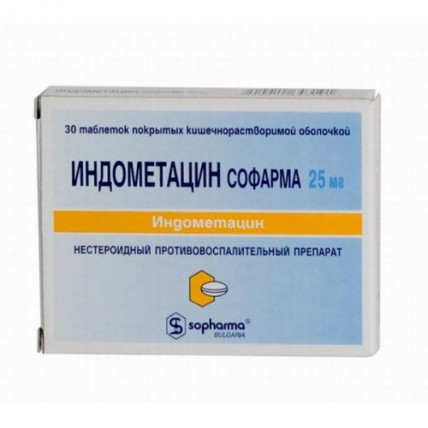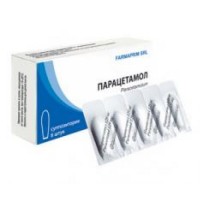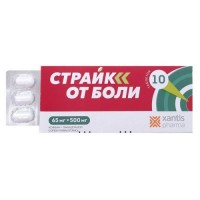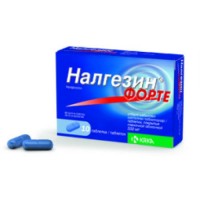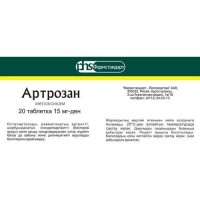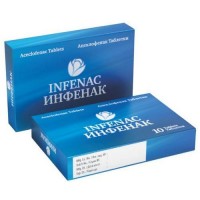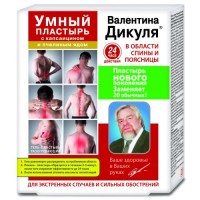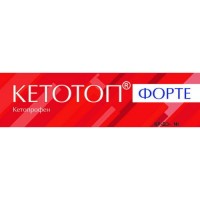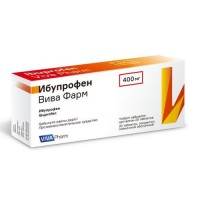Indomethacin-Sopharma 30s 25 mg coated tablets
- $2.70
The instruction on medical primeneniyulekarstvenny means
Sopharm Indometacin
the Trade name Sopharm Indometacin
the International unlicensed
name Indometacin Dosage Form Tablet,
One tablet covered with a kishechnorastvorimy cover of 25 mg Structure contains active agent: indometacin of 25 mg, excipients: structure of a kernel of a tablet: lactoses monohydrate, starch wheat, cellulose microcrystalline (type 101), K25 povidone, magnesium stearate, silicon dioxide colloidal anhydrous, talc. structure of a cover: 30% dispersion of copolymer of methacrylic acid: ethyl acrylate (1:1), 30% methyl acrylate copolymer dispersion: methacrylate methyl: methacrylic acid, sodium hydroxide, polysorbate 80, pigmentary suspension – brown (talc, triethyl citrate, the titan dioxide (E171), ferrous oxide yellow (E172), ferrous oxide red (E172), propane-1.2 a diol alginate, potassium sorbate), trietit citrate.
The description the Round, biconvex tablets covered with a kishechnorastvorimy cover, orange-brown color with a diameter of 7 mm.
Pharmacotherapeutic group Anti-inflammatory and antirheumatic drugs. Non-steroidal anti-inflammatory drugs. Acetic acid derivatives. Indometacin. ATX M01AB01 code
Pharmacological VsasyvaniePosle's svoystvapharmakokinetika of intake up to 80-90% of the accepted dose is soaked up in a small intestine, and in weaker degree in a stomach. The maximum level in plasma is defined in 1-2 hours. It RaspredelenieRaspredelyatsya in all fabrics and bodies. Also the blood-brain barrier gets through placentary. Gets through a synovial membrane into joints, and its concentration in synovial fluid is higher, than in plasma. Contacts plasma proteins in 90-98% and has ability to force out other medicines from communication with proteins and to enhance their therapeutic effect at simultaneous use. It MetabolizmMetabolizirutsya in a liver by means of oxidation and a konjyugirovaniye. VyvedeniePeriod of semi-removal of indometacin varies from 2.6 to 11.2 h or it averages 5.8 hours. It is allocated through kidneys in 60-75% from 10-20% in which not changed type, and other quantity is distinguished with bile and a stake. It is allocated with breast milk. PharmakodinamikaIndometatsin of Sopharm - derivative indolacetic acid also belongs to group of nonsteroid anti-inflammatory medicines. Possesses the significant anti-inflammatory action which considerably exceeds effect of phenylbutazone and acetylsalicylic acid. Its analgetic activity is commensurable with activity of metamizol. Possesses antipyretic action. Indometacin has the powerful oppressing effect on synthesis of prostaglandins by cyclooxygenase suppression. Besides, reduces both aggregation of thrombocytes and lipoksigenazny activity in the inflamed site, respectively, and leukotrienes, release of endogenous pyrogens also lowers, inactivates lysosomic enzymes, suppresses activity of neutral proteases. Also its other effects, such as dekupelirovaniye of oxidizing phosphorylation and suppression of the return capture of catecholamines, strengthening of exchange of noradrenaline and the known ganglioblokiruyushchy action can matter.
Indications Short-term symptomatic treatment: - acute and chronic pains in inflammatory and degenerative diseases of the musculoskeletal system: a pseudorheumatism, sharp and in an aggravation stage a chronic ankylosing spondylarthritis (Bekhterev's disease), an attack of gout and gouty arthritis, psoriasis arthritis, a disease of Reuters, - diseases of circumarticular fabrics: tendinites, a bursitis, tendobursita, a tendovaginitis, injuries at athletes,
the Route of administration and doses of the Tablet are applied inside after meal. Tablets are swallowed entirely, washing down with enough water. Frequency of side effects can be reduced, applying to control of symptoms perhaps the lowest effective dose for perhaps shortest term.Adults and teenagers are more senior the 18th letnachalny dose makes 25-50 mg (1-2 tablets) 2-4 times a day. At insufficient therapeutic effect the dose is increased to 150 mg a day, divided in three steps. The maximum daily dose makes 200 mg. At long treatment the daily dose should not exceed 75 mg. PodagraDlya stoppings of a bad gouty attack appoint the initial dose making 100 mg then continue treatment in a dose on 50 mg 3 times a day before reduction of pain. Patients of advanced age (65 years are more senior) there Is an increased risk of side effects. The lowest effective dose, for perhaps shortest term is recommended. It is necessary to observe patients on the relation of possible bleeding from digestive tract. Children are younger 18-year-old to the vozrastena use of indometacin for children to the 18th summer age as they have no enough data on safety and efficiency of drug is recommended.
Side effects Side effects are classified below by frequency. Frequency is defined as follows: very frequent (≥1/10), frequent (≥1/100 to & lt, 1/10), infrequent (≥1/1,000 to & lt, 1/100), rare (≥1/10,000 to & lt, 1/1,000), very rare (& lt, 1/10,000), with an unknown frequency (on the basis of the existing data it is impossible to make assessment).
Very often: (with the probability of emergence in more than 1 on 10 patients): - gastrointestinal disturbances. Appearance of a round ulcer, perforation or bleeding from digestive tract (sometimes with a fatal outcome) mainly at patients of advanced age Often is possible: (with emergence probability at 1 up to 10 patients on 100) include: - dizziness, a headache, somnolence, a depression, fatigue - nausea, vomiting, diarrhea, dyspepsia, a constipation, pain in zhivotenechasto: (with emergence probability at 1 up to 10 patients on 1,000) include: - a leukopenia, thrombocytopenia, an agranulocytosis, hemolytic anemia, aplastic anemia, disseminate intravascular coagulation (IDCS) - a delay of liquids, a hyperglycemia, a glucosuria, a hyperpotassemia - the indisposition, uneasiness, weakness, concentration disturbance including paresthesia, a disorientation, insomnia, irritability, a peripheral neuropathy, dysmnesias, psychotic reactions, a syncope, spasms, mishechny weakness, sensitive disturbances, a dysarthtia, nervousness - involuntary movements, confusion of consciousness - depersonalization, hallucinations, drowsiness, spasms, epilepsy - parkinsonism - a diplopia, the obscured sight - tachycardia, stenocardia, palpitation, arrhythmia, swell - arterial hypertension, hypotension - a meteorism, a melena, gematemez, a stomacace, exacerbation of the existing ulcer, exacerbation of ulcer colitis, Crohn's disease - an itching with or without rashes, urticaria, petechias, ecchymomas - a proteinuria, a hamaturia, interstitial nephrite - an acute renal failure, a nephrotic syndrome - papillary nekrozredko: (with emergence probability at 1 up to 10 patients on 10,000) include: - toxic hepatitis with or without zheltukhiochen it is rare: (with the probability of emergence in less than 1 on 10,000 patients) include: - a bronchospasm, asthmatic attacks, anaphylactic or anaphylactoid reactions - hearing disorder, sonitus - deterioration in the heart failure connected with use NPVSKlinicheskiy researches and epidemiological data show that use of some NPVS (especially in high doses and at prolonged use) can be connected with poorly increased risk of arterial trombotichesky events (for example, a myocardial infarction or a stroke) - fulminantny hepatitis - exfoliative dermatitis, a purpura, an erythema knotty, an erythema mnogoformny, violent rashes, inclusive Stephens-Johnson's syndrome and a toxic epidermal necrolysis. Influence on results of laboratory and tool researches: The increase in levels of serumal aminotransferases (ALT, AST) passing increase in bilirubin.
Contraindications - Hypersensitivity to active or to any of drug excipients - Hypersensitivity to acetylsalicylic acid or other non-steroidal anti-inflammatory drugs with clinical manifestation of an asthmatic attack, urticaria or rhinitis, polyps mucous a nose - Anamnestic data on the gastrointestinal hemorrhages or perforation caused by use of NPVS in the past - the Active or recurrent round ulcer / bleeding from a stomach and a duodenum (two or more cases of the proved ulcers or hemorrhage), ulcer colitis and/or a coloenteritis, Crohn's disease - Heavy heart failure, congenital defects serdtsa-Tyazhelaya a liver and renal failure - Indometacin is contraindicated for treatment of perioperativny pain when performing coronary shunting (CABG) - Pregnancy and the period of a lactation - Children are younger 18-year-old vozrasta-Gemofiliya, hypocoagulation and other diseases of blood.
Medicinal interactions Simultaneous use of indometacin with: Other NPVS, alcohol: Simultaneous use of indometacin with other NPVS and alcohol increases risk of development of side effects from digestive tract. Diflunizal: Increases plasma level and lowers renal clearance of indometacin. Appearance of fatal gastrointestinal hemorrhages is possible. This combination is not recommended. Digoxin: Indometacin can increase concentration of digoxin in plasma (reduces discharge it through kidneys) that demands dose adjustment and tracking level of digoxin. Lithium Salt : Indometacin extends and exponentiates effect of salts of lithium and increases lithium toxicity that demands tracking level of lithium. Immunosuppressors: Simultaneous use of indometacin and immunosuppressors, such as methotrexate and cyclosporine, leads to strengthening of their toxicity. Diuretics (diuretic): NPVS lower therapeutic effectiveness of diuretics (because of reduction of their tubular secretion). Increase in risk of emergence of a hyperpotassemia at combined use about potassium the preserving diuretics is possible and decrease in renal functions with the increased risk of an acute renal failure at the combined use with thiazide diuretics (Triamterenum) Diuretics can increase nephrotoxicity of indometacin. Antihypertensive drugs: Indometacin can weaken antihypertensive effect of APF inhibitors and beta-blockers at simultaneous use. Corticosteroids: The increased risk of gastrointestinal ultseration and hemorrhages. Anticoagulants: The risk of ultseration and hemorrhages, obuslenny suppression of trombotsitny function and aggressive action increases by mucous digestive tract. It is necessary to control a bleeding time and a prothrombin time. Indometacin competitively interacts with coumarinic anticoagulants in places of linking with proteins of plasma, their plasma concentration as a result increase. In cases of their simultaneous use indometacin is appointed in the lowest possible dose and the possibility of appointment of protective agents is discussed. Antiagreganta and selective serotonin reuptake inhibitors (SSRIs): The increased risk of gastrointestinal bleeding. Hinolona's : Combined use of hinolon and indometacin can increase risk of appearance of spasms in patients with or without anamnestic data on epilepsy or spasms. Probenetsid: Slows down excretion and increases toxicity of indometacin. Antidiabetic means: Indometacin does not change therapeutic effectiveness of oral antidiabetic means and insulin in spite of the fact that there are observations about hypo - or hyper glycemic action at their simultaneous use.
Special instructions Obshchiye-Side effects can be reduced, using for control of symptoms perhaps the lowest effective dose of drug during perhaps shortest span both gastrointestinal and cardiovascular risk factors stated below).- It is necessary to avoid simultaneous use of indometacin with other medicine from the NPVS group, inclusive selection TsOG-2 inhibitors. - At use of medicines from the NPVS group there is a risk of development of a hyperpotassemia, especially at patients 65 years are more senior, than patients with a renal failure, patients who are treated by beta-blockers, APF inhibitors and potassium the preserving diuretics. At such patients it is necessary to control potassium level in blood serum. - It is applied with extra care at patients with manifestations of hypersensitivity to foodstuff and medicines, patients with allergic diseases have a senny cold, bronchial asthma, nasal polyposes.
Patients of advanced age (65 years are more senior) Use of NPVS for patients are more senior than 65 years causes side effects, mainly gastrointestinal hemorrhage or perforation, sometimes fatal
Gastrointestinal hemorrhages, ultseration and perforation more often - Gastrointestinal hemorrhages, ultseration and perforation (sometimes with a lethal outcome) are observed at use of all NPVS during treatment, at existence or without the warning symptoms or data on the previous serious incidents from digestive tract at any time. - The risk of emergence of side effects from digestive tract happens higher at use of high doses of NPVS, at patients to anamnestic data on the ulcer which is especially complicated by hemorrhage or perforation and at patients of advanced age. At such patients the treatment of NPVS should be begun with the lowest possible dose, in view of need of prescribing of protective medicines (for example, a mizoprostol or inhibitors of the proton pump). This approach is recommended also in cases of simultaneous use of low doses of acetylsalicylic acid or other medicines which increase risk of gastrointestinal complications (corticosteroids, anticoagulants, antiagregant, selective serotonin reuptake inhibitors). - The special care is required at treatment of patients with other diseases of digestive tract (ulcer colitis, Crohn's disease) which can become aggravated at use of NPVS. - Increase in risk of complications from digestive tract exists at patients who abuse alcohol or smokers therefore their treatment needs to be carried out with extra care. - Patients with anamnestic data on gastrointestinal problems (especially sick advanced age) it is necessary to advise to report about unusual abdominal symptoms (especially about gastrointestinal hemorrhages), especially in an initiation of treatment. - The special care is required at treatment of patients by medicines which can increase risk of ultseration or bleeding (oral corticosteroids, anticoagulants, such as warfarin, selective serotonin reuptake inhibitors or antiagregant, such as acetylsalicylic acid - Use of medicine should be stopped at appearance of gastrointestinal hemorrhages and ultseration.
Disturbances from a cardiovascular system and cerebral circulation - need to be provided suitable observation and advice to patients with anamnestic data on hypertensia and/or easy to moderate stagnant heart failure as there are messages about hypostases and a delay of the liquids connected with treatment of NPVS. - Clinical trials and epidemiological data show that use of some NPVS (especially in high doses and at prolonged use) can be connected with weak increase in risk of arterial trombotichesky events (for example, an infarction of myocardial or a stroke). There are no enough data for an exception of such risk in relation to indometacin.- Patients with uncontrollable hypertensia, the stagnant heart failure established by coronary heart disease, a disease of peripheral arteries and/or a vascular and brain disease should be treated indometacin only after careful assessment of a ratio advantage/risk. - Such discussion is necessary also prior to long-term treatment of patients with risk factors on the relation of cardiovascular events (for example, hypertensia, a lipidemia, diabetes, smoking).
Skin reactions Serious skin reactions including with a lethal outcome, are observed very seldom at use of NPVS and concern cases of exfoliative dermatitis, Stephens-Johnson's syndrome, a toxic epidermal necrolysis. The highest risk of emergence of the specified reactions is shown in an initiation of treatment (in the first month). Use of medicine should be stopped at emergence still of the first skin or other symptoms of hypersensitivity.
Renal reactions Indometacin is applied with care at patients with renal diseases (clearance of creatinine & lt, 30 ml) because of possible renal defeat.
Patients need to appoint hematologic reactions with care with the anamnesis of the broken coagulation as medicine suppresses biosynthesis of prostaglandins and influences function of thrombocytes.
Hepatic reactions Treatment by indometacin, as well as other medicines from the NPVS group, at prolonged use can cause changes of hepatic function that demands periodic control of liver enzymes.
Cases infektsiiv result of the existing anti-inflammatory effect of medicine, he can disguise symptoms of an acute inflammation that demands to exclude a prisustviye of a bacterial infection at its appointment.
Mental reactions it Is applied with care at patients with mental disturbances, a depression, epilepsy, parkinsonism as can lead to deterioration in a basic disease.
Excipients - as excipient the structure of tablets includes lactose. Patients with rare hereditary problems of intolerance of a galactose, deficiency of Lapp lactase or malabsorption of glucose galactose, should not take this medicine. - As excipient wheat starch is a part of tablets. Wheat starch may contain only traces of gluten and it is considered safe for people with a Gee's disease.
Fertility, pregnancy and breastfeeding Pregnancy: use of NPVS, as well as all other inhibitors of synthesis of prostaglandins, in the first months of pregnancy is connected with the increased risk of spontaneous abortion and malformation (renal defeats, heart malformation). The risk increases at use of high doses throughout a long time. Use of NPVS in the last 3 months of pregnancy can lead to lengthening of a bleeding time at mother and the child (antiagregantny effect which can appear even at use of low doses) and to suppression of reductions of a uterus that leads to delay or lengthening of childbirth. The indometacin applied in high doses in the last trimester of pregnancy can cause premature closing of an arterial channel in a fruit with the subsequent persistent pulmonary hypertensia. Indometacin can cause damage of kidneys which can progress to a renal failure and an oligogidramnion. Breastfeeding: because of removal with breast milk, its use during breastfeeding is contraindicated or demands the feeding termination by a breast during treatment. Influence on fertility: women of reproductive age have a risk of reversible suppression of fertility at medicine use.
Features of influence of medicine on ability to run the vehicle or potentially dangerous mekhanizmamiindometatsin Sopharm can cause side effects (sonitus, dizziness, drowsiness, acoustical and visual disturbances) which can break active attention and reflexes and to influence ability to run vehicles and to work with cars.
Overdose Symptoms: nausea, vomiting, abdominal pain, severe headache, dizziness, disturbances of memory and disorientation. In more hard cases paresthesias and spasms are observed. Treatment: symptomatic and supporting. The hemodialysis is not effective.
A form of release and upakovkapo 30 tablets covered with a kishechnorastvorimy cover in blister strip packaging from firm, colourless, transparent film PVC / aluminum foil. 1 blister strip packaging together with the instruction for medical use in the state and Russian languages is put in a pack from cardboard.
Storage conditions In original packing, at a temperature not higher than 25 wasps. To store out of children's reach.
Not to accept a period of storage of 5 years after an expiration date.
Prescription status from aptekpo to the prescription
Producer JSC Sopharm, Bolgariyaul. Ilinskoye Highway 16, 1220 Sofia, Bulgaria
the Name and the country of the owner registration udostovereniyaao Sopharm, Bulgaria
to Develop
Sopharm Indometacin
the Trade name Sopharm Indometacin
the International unlicensed
name Indometacin Dosage Form Tablet,
One tablet covered with a kishechnorastvorimy cover of 25 mg Structure contains active agent: indometacin of 25 mg, excipients: structure of a kernel of a tablet: lactoses monohydrate, starch wheat, cellulose microcrystalline (type 101), K25 povidone, magnesium stearate, silicon dioxide colloidal anhydrous, talc. structure of a cover: 30% dispersion of copolymer of methacrylic acid: ethyl acrylate (1:1), 30% methyl acrylate copolymer dispersion: methacrylate methyl: methacrylic acid, sodium hydroxide, polysorbate 80, pigmentary suspension – brown (talc, triethyl citrate, the titan dioxide (E171), ferrous oxide yellow (E172), ferrous oxide red (E172), propane-1.2 a diol alginate, potassium sorbate), trietit citrate.
The description the Round, biconvex tablets covered with a kishechnorastvorimy cover, orange-brown color with a diameter of 7 mm.
Pharmacotherapeutic group Anti-inflammatory and antirheumatic drugs. Non-steroidal anti-inflammatory drugs. Acetic acid derivatives. Indometacin. ATX M01AB01 code
Pharmacological VsasyvaniePosle's svoystvapharmakokinetika of intake up to 80-90% of the accepted dose is soaked up in a small intestine, and in weaker degree in a stomach. The maximum level in plasma is defined in 1-2 hours. It RaspredelenieRaspredelyatsya in all fabrics and bodies. Also the blood-brain barrier gets through placentary. Gets through a synovial membrane into joints, and its concentration in synovial fluid is higher, than in plasma. Contacts plasma proteins in 90-98% and has ability to force out other medicines from communication with proteins and to enhance their therapeutic effect at simultaneous use. It MetabolizmMetabolizirutsya in a liver by means of oxidation and a konjyugirovaniye. VyvedeniePeriod of semi-removal of indometacin varies from 2.6 to 11.2 h or it averages 5.8 hours. It is allocated through kidneys in 60-75% from 10-20% in which not changed type, and other quantity is distinguished with bile and a stake. It is allocated with breast milk. PharmakodinamikaIndometatsin of Sopharm - derivative indolacetic acid also belongs to group of nonsteroid anti-inflammatory medicines. Possesses the significant anti-inflammatory action which considerably exceeds effect of phenylbutazone and acetylsalicylic acid. Its analgetic activity is commensurable with activity of metamizol. Possesses antipyretic action. Indometacin has the powerful oppressing effect on synthesis of prostaglandins by cyclooxygenase suppression. Besides, reduces both aggregation of thrombocytes and lipoksigenazny activity in the inflamed site, respectively, and leukotrienes, release of endogenous pyrogens also lowers, inactivates lysosomic enzymes, suppresses activity of neutral proteases. Also its other effects, such as dekupelirovaniye of oxidizing phosphorylation and suppression of the return capture of catecholamines, strengthening of exchange of noradrenaline and the known ganglioblokiruyushchy action can matter.
Indications Short-term symptomatic treatment: - acute and chronic pains in inflammatory and degenerative diseases of the musculoskeletal system: a pseudorheumatism, sharp and in an aggravation stage a chronic ankylosing spondylarthritis (Bekhterev's disease), an attack of gout and gouty arthritis, psoriasis arthritis, a disease of Reuters, - diseases of circumarticular fabrics: tendinites, a bursitis, tendobursita, a tendovaginitis, injuries at athletes,
the Route of administration and doses of the Tablet are applied inside after meal. Tablets are swallowed entirely, washing down with enough water. Frequency of side effects can be reduced, applying to control of symptoms perhaps the lowest effective dose for perhaps shortest term.Adults and teenagers are more senior the 18th letnachalny dose makes 25-50 mg (1-2 tablets) 2-4 times a day. At insufficient therapeutic effect the dose is increased to 150 mg a day, divided in three steps. The maximum daily dose makes 200 mg. At long treatment the daily dose should not exceed 75 mg. PodagraDlya stoppings of a bad gouty attack appoint the initial dose making 100 mg then continue treatment in a dose on 50 mg 3 times a day before reduction of pain. Patients of advanced age (65 years are more senior) there Is an increased risk of side effects. The lowest effective dose, for perhaps shortest term is recommended. It is necessary to observe patients on the relation of possible bleeding from digestive tract. Children are younger 18-year-old to the vozrastena use of indometacin for children to the 18th summer age as they have no enough data on safety and efficiency of drug is recommended.
Side effects Side effects are classified below by frequency. Frequency is defined as follows: very frequent (≥1/10), frequent (≥1/100 to & lt, 1/10), infrequent (≥1/1,000 to & lt, 1/100), rare (≥1/10,000 to & lt, 1/1,000), very rare (& lt, 1/10,000), with an unknown frequency (on the basis of the existing data it is impossible to make assessment).
Very often: (with the probability of emergence in more than 1 on 10 patients): - gastrointestinal disturbances. Appearance of a round ulcer, perforation or bleeding from digestive tract (sometimes with a fatal outcome) mainly at patients of advanced age Often is possible: (with emergence probability at 1 up to 10 patients on 100) include: - dizziness, a headache, somnolence, a depression, fatigue - nausea, vomiting, diarrhea, dyspepsia, a constipation, pain in zhivotenechasto: (with emergence probability at 1 up to 10 patients on 1,000) include: - a leukopenia, thrombocytopenia, an agranulocytosis, hemolytic anemia, aplastic anemia, disseminate intravascular coagulation (IDCS) - a delay of liquids, a hyperglycemia, a glucosuria, a hyperpotassemia - the indisposition, uneasiness, weakness, concentration disturbance including paresthesia, a disorientation, insomnia, irritability, a peripheral neuropathy, dysmnesias, psychotic reactions, a syncope, spasms, mishechny weakness, sensitive disturbances, a dysarthtia, nervousness - involuntary movements, confusion of consciousness - depersonalization, hallucinations, drowsiness, spasms, epilepsy - parkinsonism - a diplopia, the obscured sight - tachycardia, stenocardia, palpitation, arrhythmia, swell - arterial hypertension, hypotension - a meteorism, a melena, gematemez, a stomacace, exacerbation of the existing ulcer, exacerbation of ulcer colitis, Crohn's disease - an itching with or without rashes, urticaria, petechias, ecchymomas - a proteinuria, a hamaturia, interstitial nephrite - an acute renal failure, a nephrotic syndrome - papillary nekrozredko: (with emergence probability at 1 up to 10 patients on 10,000) include: - toxic hepatitis with or without zheltukhiochen it is rare: (with the probability of emergence in less than 1 on 10,000 patients) include: - a bronchospasm, asthmatic attacks, anaphylactic or anaphylactoid reactions - hearing disorder, sonitus - deterioration in the heart failure connected with use NPVSKlinicheskiy researches and epidemiological data show that use of some NPVS (especially in high doses and at prolonged use) can be connected with poorly increased risk of arterial trombotichesky events (for example, a myocardial infarction or a stroke) - fulminantny hepatitis - exfoliative dermatitis, a purpura, an erythema knotty, an erythema mnogoformny, violent rashes, inclusive Stephens-Johnson's syndrome and a toxic epidermal necrolysis. Influence on results of laboratory and tool researches: The increase in levels of serumal aminotransferases (ALT, AST) passing increase in bilirubin.
Contraindications - Hypersensitivity to active or to any of drug excipients - Hypersensitivity to acetylsalicylic acid or other non-steroidal anti-inflammatory drugs with clinical manifestation of an asthmatic attack, urticaria or rhinitis, polyps mucous a nose - Anamnestic data on the gastrointestinal hemorrhages or perforation caused by use of NPVS in the past - the Active or recurrent round ulcer / bleeding from a stomach and a duodenum (two or more cases of the proved ulcers or hemorrhage), ulcer colitis and/or a coloenteritis, Crohn's disease - Heavy heart failure, congenital defects serdtsa-Tyazhelaya a liver and renal failure - Indometacin is contraindicated for treatment of perioperativny pain when performing coronary shunting (CABG) - Pregnancy and the period of a lactation - Children are younger 18-year-old vozrasta-Gemofiliya, hypocoagulation and other diseases of blood.
Medicinal interactions Simultaneous use of indometacin with: Other NPVS, alcohol: Simultaneous use of indometacin with other NPVS and alcohol increases risk of development of side effects from digestive tract. Diflunizal: Increases plasma level and lowers renal clearance of indometacin. Appearance of fatal gastrointestinal hemorrhages is possible. This combination is not recommended. Digoxin: Indometacin can increase concentration of digoxin in plasma (reduces discharge it through kidneys) that demands dose adjustment and tracking level of digoxin. Lithium Salt : Indometacin extends and exponentiates effect of salts of lithium and increases lithium toxicity that demands tracking level of lithium. Immunosuppressors: Simultaneous use of indometacin and immunosuppressors, such as methotrexate and cyclosporine, leads to strengthening of their toxicity. Diuretics (diuretic): NPVS lower therapeutic effectiveness of diuretics (because of reduction of their tubular secretion). Increase in risk of emergence of a hyperpotassemia at combined use about potassium the preserving diuretics is possible and decrease in renal functions with the increased risk of an acute renal failure at the combined use with thiazide diuretics (Triamterenum) Diuretics can increase nephrotoxicity of indometacin. Antihypertensive drugs: Indometacin can weaken antihypertensive effect of APF inhibitors and beta-blockers at simultaneous use. Corticosteroids: The increased risk of gastrointestinal ultseration and hemorrhages. Anticoagulants: The risk of ultseration and hemorrhages, obuslenny suppression of trombotsitny function and aggressive action increases by mucous digestive tract. It is necessary to control a bleeding time and a prothrombin time. Indometacin competitively interacts with coumarinic anticoagulants in places of linking with proteins of plasma, their plasma concentration as a result increase. In cases of their simultaneous use indometacin is appointed in the lowest possible dose and the possibility of appointment of protective agents is discussed. Antiagreganta and selective serotonin reuptake inhibitors (SSRIs): The increased risk of gastrointestinal bleeding. Hinolona's : Combined use of hinolon and indometacin can increase risk of appearance of spasms in patients with or without anamnestic data on epilepsy or spasms. Probenetsid: Slows down excretion and increases toxicity of indometacin. Antidiabetic means: Indometacin does not change therapeutic effectiveness of oral antidiabetic means and insulin in spite of the fact that there are observations about hypo - or hyper glycemic action at their simultaneous use.
Special instructions Obshchiye-Side effects can be reduced, using for control of symptoms perhaps the lowest effective dose of drug during perhaps shortest span both gastrointestinal and cardiovascular risk factors stated below).- It is necessary to avoid simultaneous use of indometacin with other medicine from the NPVS group, inclusive selection TsOG-2 inhibitors. - At use of medicines from the NPVS group there is a risk of development of a hyperpotassemia, especially at patients 65 years are more senior, than patients with a renal failure, patients who are treated by beta-blockers, APF inhibitors and potassium the preserving diuretics. At such patients it is necessary to control potassium level in blood serum. - It is applied with extra care at patients with manifestations of hypersensitivity to foodstuff and medicines, patients with allergic diseases have a senny cold, bronchial asthma, nasal polyposes.
Patients of advanced age (65 years are more senior) Use of NPVS for patients are more senior than 65 years causes side effects, mainly gastrointestinal hemorrhage or perforation, sometimes fatal
Gastrointestinal hemorrhages, ultseration and perforation more often - Gastrointestinal hemorrhages, ultseration and perforation (sometimes with a lethal outcome) are observed at use of all NPVS during treatment, at existence or without the warning symptoms or data on the previous serious incidents from digestive tract at any time. - The risk of emergence of side effects from digestive tract happens higher at use of high doses of NPVS, at patients to anamnestic data on the ulcer which is especially complicated by hemorrhage or perforation and at patients of advanced age. At such patients the treatment of NPVS should be begun with the lowest possible dose, in view of need of prescribing of protective medicines (for example, a mizoprostol or inhibitors of the proton pump). This approach is recommended also in cases of simultaneous use of low doses of acetylsalicylic acid or other medicines which increase risk of gastrointestinal complications (corticosteroids, anticoagulants, antiagregant, selective serotonin reuptake inhibitors). - The special care is required at treatment of patients with other diseases of digestive tract (ulcer colitis, Crohn's disease) which can become aggravated at use of NPVS. - Increase in risk of complications from digestive tract exists at patients who abuse alcohol or smokers therefore their treatment needs to be carried out with extra care. - Patients with anamnestic data on gastrointestinal problems (especially sick advanced age) it is necessary to advise to report about unusual abdominal symptoms (especially about gastrointestinal hemorrhages), especially in an initiation of treatment. - The special care is required at treatment of patients by medicines which can increase risk of ultseration or bleeding (oral corticosteroids, anticoagulants, such as warfarin, selective serotonin reuptake inhibitors or antiagregant, such as acetylsalicylic acid - Use of medicine should be stopped at appearance of gastrointestinal hemorrhages and ultseration.
Disturbances from a cardiovascular system and cerebral circulation - need to be provided suitable observation and advice to patients with anamnestic data on hypertensia and/or easy to moderate stagnant heart failure as there are messages about hypostases and a delay of the liquids connected with treatment of NPVS. - Clinical trials and epidemiological data show that use of some NPVS (especially in high doses and at prolonged use) can be connected with weak increase in risk of arterial trombotichesky events (for example, an infarction of myocardial or a stroke). There are no enough data for an exception of such risk in relation to indometacin.- Patients with uncontrollable hypertensia, the stagnant heart failure established by coronary heart disease, a disease of peripheral arteries and/or a vascular and brain disease should be treated indometacin only after careful assessment of a ratio advantage/risk. - Such discussion is necessary also prior to long-term treatment of patients with risk factors on the relation of cardiovascular events (for example, hypertensia, a lipidemia, diabetes, smoking).
Skin reactions Serious skin reactions including with a lethal outcome, are observed very seldom at use of NPVS and concern cases of exfoliative dermatitis, Stephens-Johnson's syndrome, a toxic epidermal necrolysis. The highest risk of emergence of the specified reactions is shown in an initiation of treatment (in the first month). Use of medicine should be stopped at emergence still of the first skin or other symptoms of hypersensitivity.
Renal reactions Indometacin is applied with care at patients with renal diseases (clearance of creatinine & lt, 30 ml) because of possible renal defeat.
Patients need to appoint hematologic reactions with care with the anamnesis of the broken coagulation as medicine suppresses biosynthesis of prostaglandins and influences function of thrombocytes.
Hepatic reactions Treatment by indometacin, as well as other medicines from the NPVS group, at prolonged use can cause changes of hepatic function that demands periodic control of liver enzymes.
Cases infektsiiv result of the existing anti-inflammatory effect of medicine, he can disguise symptoms of an acute inflammation that demands to exclude a prisustviye of a bacterial infection at its appointment.
Mental reactions it Is applied with care at patients with mental disturbances, a depression, epilepsy, parkinsonism as can lead to deterioration in a basic disease.
Excipients - as excipient the structure of tablets includes lactose. Patients with rare hereditary problems of intolerance of a galactose, deficiency of Lapp lactase or malabsorption of glucose galactose, should not take this medicine. - As excipient wheat starch is a part of tablets. Wheat starch may contain only traces of gluten and it is considered safe for people with a Gee's disease.
Fertility, pregnancy and breastfeeding Pregnancy: use of NPVS, as well as all other inhibitors of synthesis of prostaglandins, in the first months of pregnancy is connected with the increased risk of spontaneous abortion and malformation (renal defeats, heart malformation). The risk increases at use of high doses throughout a long time. Use of NPVS in the last 3 months of pregnancy can lead to lengthening of a bleeding time at mother and the child (antiagregantny effect which can appear even at use of low doses) and to suppression of reductions of a uterus that leads to delay or lengthening of childbirth. The indometacin applied in high doses in the last trimester of pregnancy can cause premature closing of an arterial channel in a fruit with the subsequent persistent pulmonary hypertensia. Indometacin can cause damage of kidneys which can progress to a renal failure and an oligogidramnion. Breastfeeding: because of removal with breast milk, its use during breastfeeding is contraindicated or demands the feeding termination by a breast during treatment. Influence on fertility: women of reproductive age have a risk of reversible suppression of fertility at medicine use.
Features of influence of medicine on ability to run the vehicle or potentially dangerous mekhanizmamiindometatsin Sopharm can cause side effects (sonitus, dizziness, drowsiness, acoustical and visual disturbances) which can break active attention and reflexes and to influence ability to run vehicles and to work with cars.
Overdose Symptoms: nausea, vomiting, abdominal pain, severe headache, dizziness, disturbances of memory and disorientation. In more hard cases paresthesias and spasms are observed. Treatment: symptomatic and supporting. The hemodialysis is not effective.
A form of release and upakovkapo 30 tablets covered with a kishechnorastvorimy cover in blister strip packaging from firm, colourless, transparent film PVC / aluminum foil. 1 blister strip packaging together with the instruction for medical use in the state and Russian languages is put in a pack from cardboard.
Storage conditions In original packing, at a temperature not higher than 25 wasps. To store out of children's reach.
Not to accept a period of storage of 5 years after an expiration date.
Prescription status from aptekpo to the prescription
Producer JSC Sopharm, Bolgariyaul. Ilinskoye Highway 16, 1220 Sofia, Bulgaria
the Name and the country of the owner registration udostovereniyaao Sopharm, Bulgaria
to Develop
